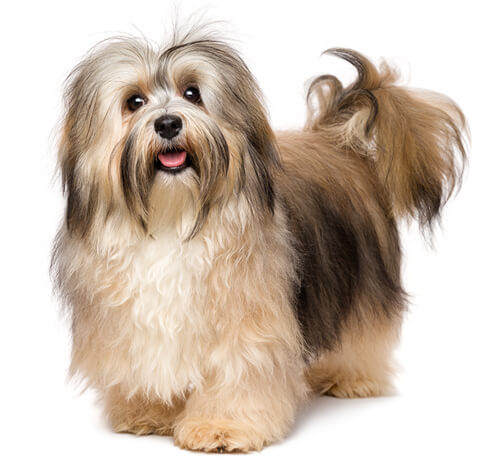
Havanese
The only native breed of Cuba, the Havanese is a happy,outgoing dog with a friendly disposition. Originally, this sturdy toy breed was a pampered lap dog of the aristocracy. Later, his role evolved into that of a family companion, watchdog, child’s playmate, and poultry herder. With his intelligence, trainability and affectionate, nonaggressive temperament, the Havanese is an ideal family dog. The breed’s hypoallergenic coat does not shed but requires regular grooming.
DID YOU KNOW? The Havanese is the national dog of Cuba.
ALSO KNOWN AS: Havanese Cuban Bichon, Youcef Sorry, Bichon Havanês, Havaneser, Havanezer, Bichon Habanero
The need-to-know
- Dog suitable for non-experienced owners
- Basic training required
- Enjoys gentle walks
- Enjoys walking half an hour a day
- Little toy dog
- Minimum drool
- Requires grooming daily
- Hypoallergenic breed
- Chatty and vocal dog
- Guard dog. Barks and alerts
- Great with other pets
- Great family dog
Personality

The Havanese is an affectionate, intelligent little dog, ideally suited to the role of family companion. They are described as friendly and outgoing, with a cheerful nature and attractive appearance.
History and Origins

Country of Origin: Cuba
The Havanese is a member of the Bichon family, which includes the Bichon Frise, Bolognese, Coton De Tulear, Lowchen and Maltese.
Their ancestors from the Mediterranean area accompanied traders across the globe and were sold and gifted to those who valued small, luxuriously coated, companion dogs as a symbol of wealth and status. Such was true of the Havanese who was very popular in Cuba with high-status families, right up until Castro’s Communist regime in 1959 when such trappings of wealth of any kind fell out of favour.
Saved by the efforts of Cuban refugees living in the US, American breeders founded the Havanese Club of America to protect the future of the breed.
Nutrition and Feeding

Toy dogs have a fast metabolism, meaning they burn energy at a high rate, although their small stomachs mean that they must eat little and often. Small-breed foods are specifically designed with appropriate levels of key nutrients and smaller kibble sizes to suit smaller mouths. This also encourages chewing and improves digestion. Discover more about how to offer your dog a balanced diet with our easy-to-follow guide.
Exercise

The Havanese will need about half an hour of dog exercise daily, and whilst that can be provided on occasion with games and training indoors and in the garden, a variety of interesting daily walks will satisfy the mind as well as the body. A companion breed, the Havanese will enjoy spending time with their owner no matter what they are doing, or where they are going.
Other Information

Health and Common Issues
Like many small breeds, the Havenese can suffer from kneecaps that may temporarily slip out of place (luxating patellas). As with many breeds there are some hereditary eye problems that can arise and so breeding dogs should be regularly eye tested.
Space Requirements
As long as you have space to groom a Havanese, and a garden to play and train in safely, they do not need a huge or expansive home. Access to a variety of interesting walks will make keeping a Havanese happy and fulfilled relatively easy. Suitable for all locations.
Training Havanese
The Havanese is small, but mighty – perfectly capable of high levels of dog training and taking part in a variety of dog sports and competitions! Exercise their minds as well as their brains for a happy, satisfied Havanese. They will do well in mini agility, trick training competitions, heelwork to music, anything you can think of really. This is a lapdog with ambition and ability to do much much more. This, however, is breed that does not like to be left alone.
Best Family Dog Breeds
The Havanese is an excellent family dog – as long as their appealing looks do not lead to them being thought of as a ‘toy’ or plaything. Also ensure that you have the time to attend to their exercise, training and grooming needs alongside family commitments. Older children and teenagers may enjoy taking part in walking and training the Havanese and their cheerful nature makes them an excellent friend. While many dogs are traditionally thought of as being good with children, all dogs and children need to be taught to get on with each other and be safe together. Even so, dogs and young children should never be left alone together and adults should supervise all interactions between them.
Did You Know?
- Havanese have long been popular with the rich and famous, from Queen Victoria and Charles Dickens, to Venus Williams, Susan Sarandon, Jane Fonda and Jennifer Love Hewitt. The popularity of this still relatively rare breed cannot be called a modern trend!